lock RENAULT TWINGO 2016 3.G Service Manual
[x] Cancel search | Manufacturer: RENAULT, Model Year: 2016, Model line: TWINGO, Model: RENAULT TWINGO 2016 3.GPages: 216, PDF Size: 7.15 MB
Page 127 of 216
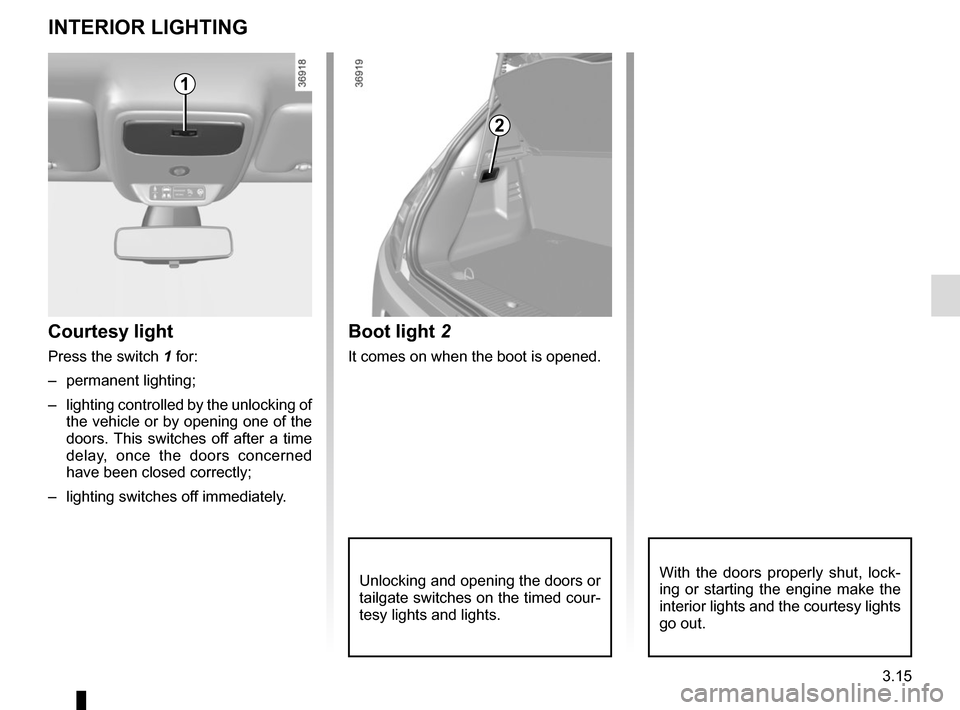
3.15
Unlocking and opening the doors or
tailgate switches on the timed cour-
tesy lights and lights.
Boot light 2
It comes on when the boot is opened.
Courtesy light
Press the switch 1 for:
– permanent lighting;
– lighting controlled by the unlocking of
the vehicle or by opening one of the
doors. This switches off after a time
delay, once the doors concerned
have been closed correctly;
– lighting switches off immediately.
INTERIOR LIGHTING
1
2
With the doors properly shut, lock-
ing or starting the engine make the
interior lights and the courtesy lights
go out.
Page 133 of 216
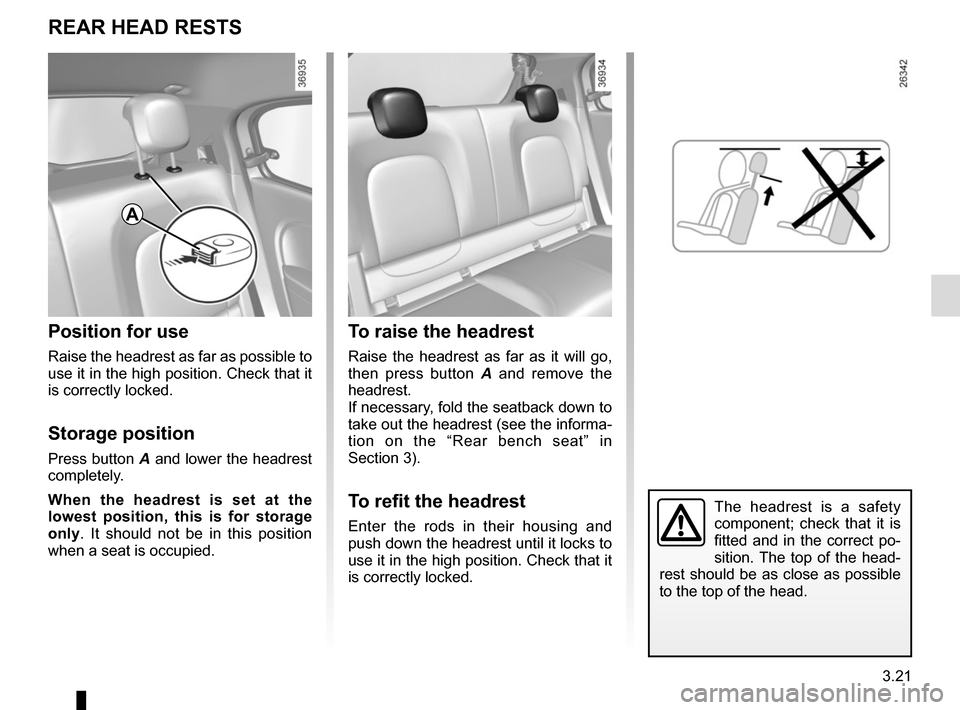
3.21
The headrest is a safety
component; check that it is
fitted and in the correct po-
sition. The top of the head-
rest should be as close as possible
to the top of the head.
To raise the headrest
Raise the headrest as far as it will go,
then press button A and remove the
headrest.
If necessary, fold the seatback down to
take out the headrest (see the informa-
tion on the “Rear bench seat” in
Section 3).
To refit the headrest
Enter the rods in their housing and
push down the headrest until it locks to
use it in the high position. Check that it
is correctly locked.
Position for use
Raise the headrest as far as possible to
use it in the high position. Check that it
is correctly locked.
Storage position
Press button A and lower the headrest
completely.
When the headrest is set at the
lowest position, this is for storage
only. It should not be in this position
when a seat is occupied.
REAR HEAD RESTS
A
Page 134 of 216
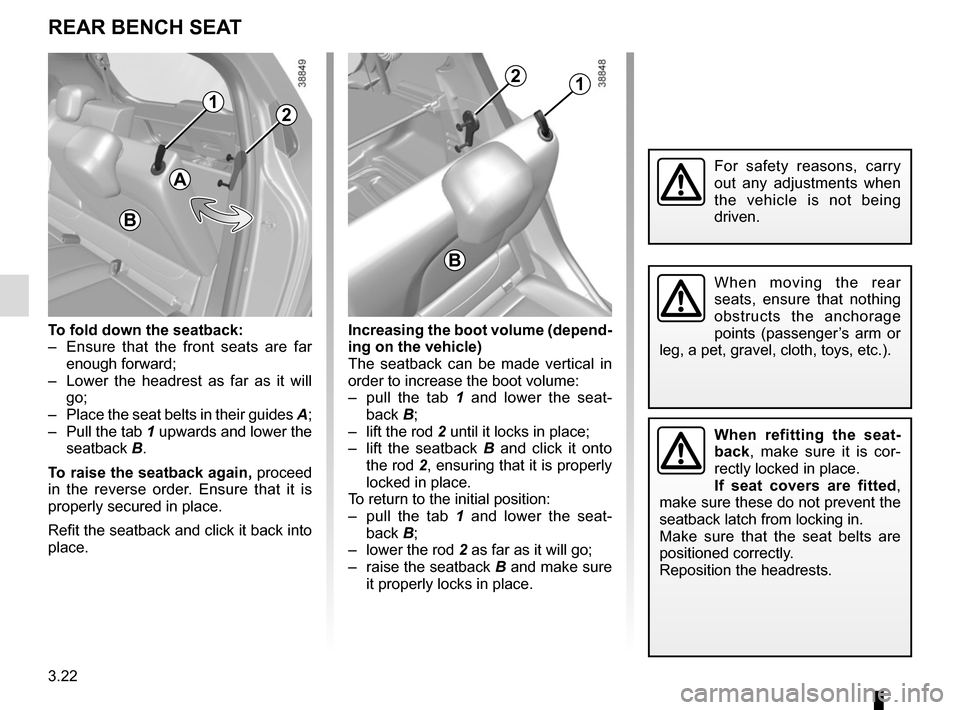
3.22
REAR BENCH SEAT
B
To fold down the seatback:
– Ensure that the front seats are far enough forward;
– Lower the headrest as far as it will go;
– Place the seat belts in their guides A;
– Pull the tab 1 upwards and lower the seatback B.
To raise the seatback again, proceed
in the reverse order. Ensure that it is
properly secured in place.
Refit the seatback and click it back into
place. Increasing the boot volume (depend-
ing on the vehicle)
The seatback can be made vertical in
order to increase the boot volume:
– pull the tab 1 and lower the seat-
back B;
– lift the rod 2 until it locks in place;
– lift the seatback B and click it onto
the rod 2, ensuring that it is properly
locked in place.
To return to the initial position:
– pull the tab 1 and lower the seat-
back B;
– lower the rod 2 as far as it will go;
– raise the seatback B and make sure it properly locks in place.
For safety reasons, carry
out any adjustments when
the vehicle is not being
driven.
When moving the rear
seats, ensure that nothing
obstructs the anchorage
points (passenger’s arm or
leg, a pet, gravel, cloth, toys, etc.).
When refitting the seat-
back, make sure it is cor-
rectly locked in place.
If seat covers are fitted ,
make sure these do not prevent the
seatback latch from locking in.
Make sure that the seat belts are
positioned correctly.
Reposition the headrests.
1
A
2
12
B
Page 135 of 216
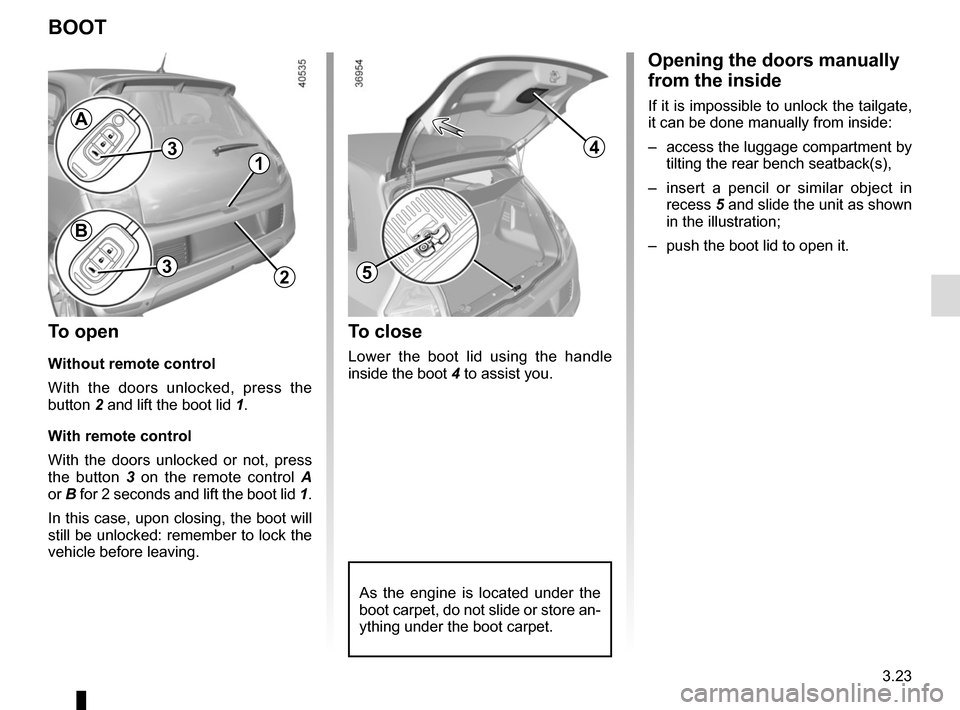
3.23
Opening the doors manually
from the inside
If it is impossible to unlock the tailgate,
it can be done manually from inside:
– access the luggage compartment by tilting the rear bench seatback(s),
– insert a pencil or similar object in recess 5 and slide the unit as shown
in the illustration;
– push the boot lid to open it.
BOOT
To open
Without remote control
With the doors unlocked, press the
button 2 and lift the boot lid 1.
With remote control
With the doors unlocked or not, press
the button 3 on the remote control A
or B for 2 seconds and lift the boot lid 1.
In this case, upon closing, the boot will
still be unlocked: remember to lock the
vehicle before leaving.
1
5
4
To close
Lower the boot lid using the handle
inside the boot 4 to assist you.
2
As the engine is located under the
boot carpet, do not slide or store an-
ything under the boot carpet.
3
A
B
3
Page 142 of 216
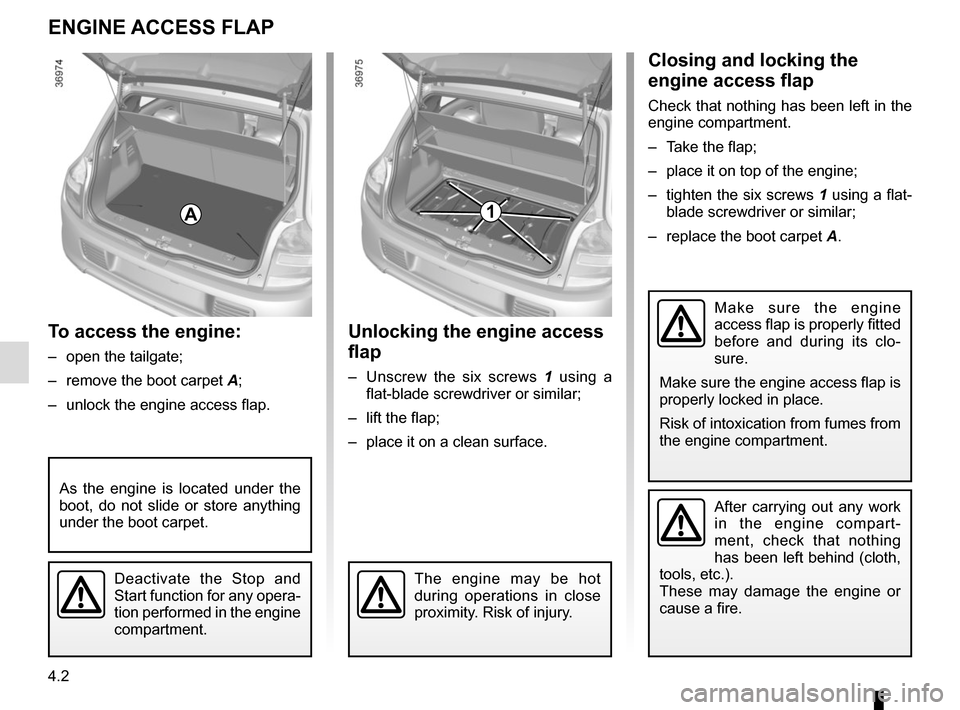
4.2
To access the engine:
– open the tailgate;
– remove the boot carpet A;
– unlock the engine access flap.
ENGINE ACCESS FLAP
Unlocking the engine access
flap
– Unscrew the six screws 1 using a
flat-blade screwdriver or similar;
– lift the flap;
– place it on a clean surface.
Closing and locking the
engine access flap
Check that nothing has been left in the
engine compartment.
– Take the flap;
– place it on top of the engine;
– tighten the six screws 1 using a flat- blade screwdriver or similar;
– replace the boot carpet A.
After carrying out any work
in the engine compart-
ment, check that nothing
has been left behind (cloth,
tools, etc.).
These may damage the engine or
cause a fire.
Make sure the engine
access flap is properly fitted
before and during its clo-
sure.
Make sure the engine access flap is
properly locked in place.
Risk of intoxication from fumes from
the engine compartment.
1A
Deactivate the Stop and
Start function for any opera-
tion performed in the engine
compartment.The engine may be hot
during operations in close
proximity. Risk of injury.
As the engine is located under the
boot, do not slide or store anything
under the boot carpet.
Page 146 of 216
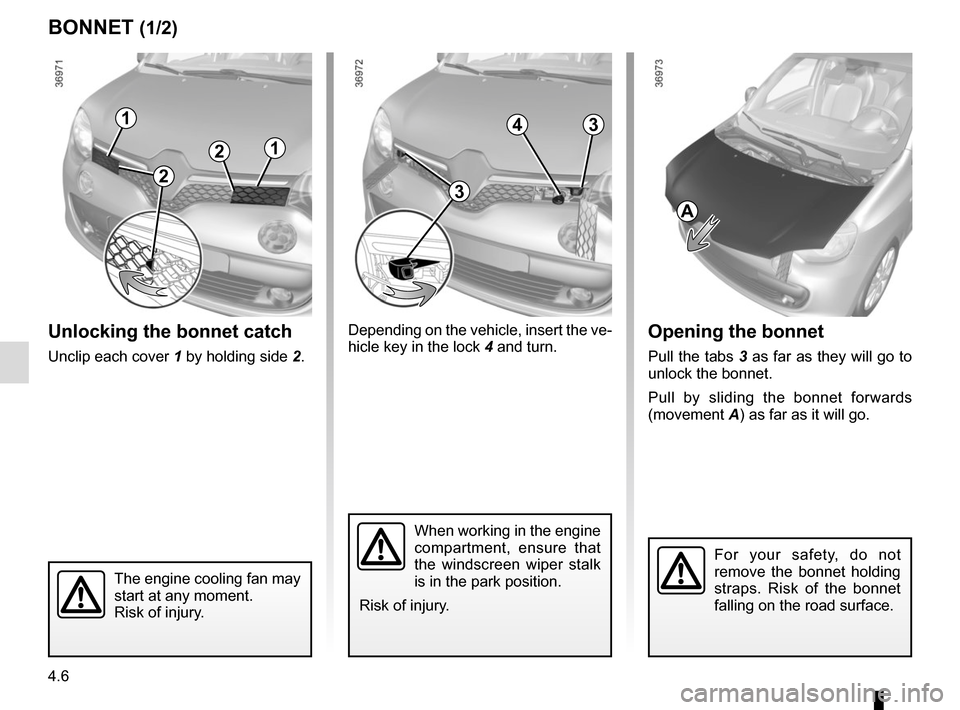
4.6
Unlocking the bonnet catch
Unclip each cover 1 by holding side 2.
BONNET (1/2)
1
The engine cooling fan may
start at any moment.
Risk of injury.
Opening the bonnet
Pull the tabs 3 as far as they will go to
unlock the bonnet.
Pull by sliding the bonnet forwards
(movement A) as far as it will go.
When working in the engine
compartment, ensure that
the windscreen wiper stalk
is in the park position.
Risk of injury.
A
43
3
For your safety, do not
remove the bonnet holding
straps. Risk of the bonnet
falling on the road surface.
Depending on the vehicle, insert the ve-
hicle key in the lock 4 and turn.
1
2
2
Page 147 of 216

4.7
BONNET (2/2)
Closing the bonnet
Slide the bonnet back until it closes
(movement B).
Ensure that the bonnet is
properly locked.
Check that nothing is pre-
venting the catch from lock-
ing (gravel, cloth, etc.).
In the event of even a slight
impact involving the radia-
tor grille or bonnet, have
the bonnet lock checked by
an approved dealer as soon as pos-
sible.
B
Locking the bonnet
– Push the tabs 3;
– depending on the vehicle, insert the vehicle key in the lock 4 and turn;
– replace the covers 1;
– clip them into their housing.
431
1
3
Page 156 of 216

4.16
Glass instrument panel(e.g.: instrument panel, clock, exterior
temperature display, radio display, mul-
timedia or multifunction display etc.)
Use a soft cloth (or cotton wool).
If this does not clean them properly,
use a soft cloth (or cotton wool) slightly
moistened with soapy water and then
wipe clean with another soft damp cloth
or cotton wool.
Finally, carefully dry off with a soft dry
cloth.
Do not use products containing alco-
hol and/or spray fluids on the area.
Seat belts
These must be kept clean.
Use products selected by our Technical
Department (Approved outlets) or
warm, soapy water and a sponge and
wipe with a dry cloth.
Detergents or dyes must not be used
under any circumstances.
INTERIOR TRIM MAINTENANCE (1/2)
Textiles (seats, door trim, etc)
Vacuum-clean the textiles regularly.
Liquid stain
Use soapy water.
Dab lightly (never rub) with a soft cloth,
rinse and remove the excess.
Solid or pasty stain
Carefully remove the excess solid or
pasty material immediately with a
spatula (working from the edges to the
centre to avoid spreading the stain).
Clean as for a liquid stain.
Special instructions for sweets or
chewing gum
Put an ice cube on the stain to solidify
it, then proceed as for a solid stain.
A well-maintained vehicle will last
longer. It is therefore recommended to
maintain the interior of the vehicle regu-
larly.
A stain should always be dealt with
swiftly.
Whatever type of stain is on the trim,
use
cold (or warm) soapy water with
natural soap.
Detergents (washing-up liquid, pow-
dered products, alcohol-based prod-
ucts) should not be used.
Use a soft cloth.
Rinse and soak up the excess.
For further recommendations for
maintaining the interior, and/or for
any unsatisfactory results, please
see an authorised dealer.
Page 169 of 216
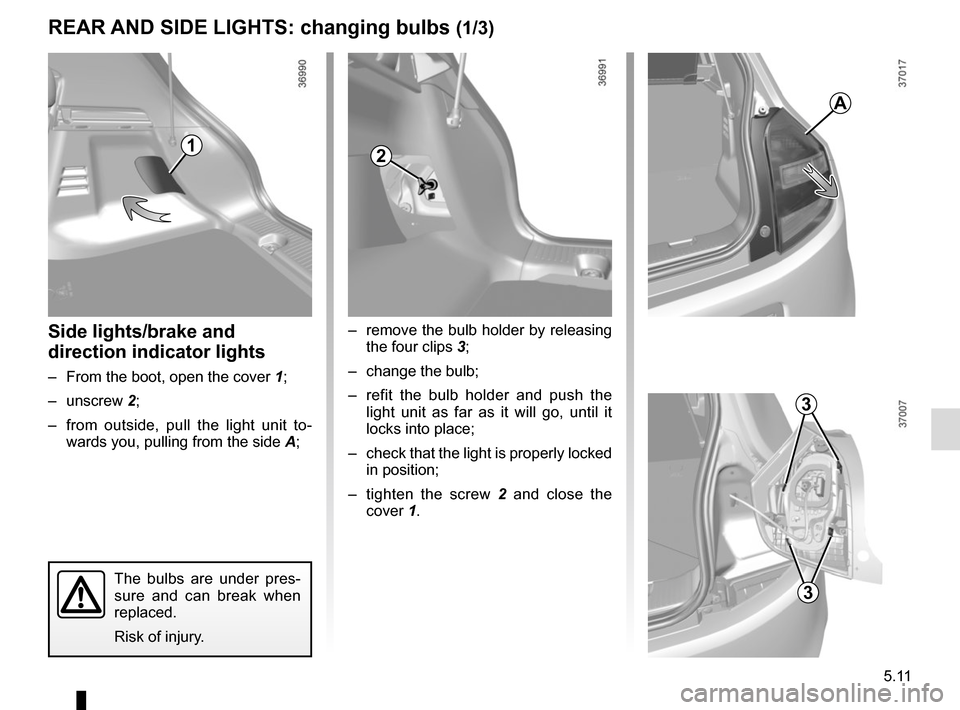
5.11
Side lights/brake and
direction indicator lights
– From the boot, open the cover 1;
– unscrew 2;
– from outside, pull the light unit to- wards you, pulling from the side A;
REAR AND SIDE LIGHTS: changing bulbs (1/3)
– remove the bulb holder by releasing
the four clips 3;
– change the bulb;
– refit the bulb holder and push the light unit as far as it will go, until it
locks into place;
– check that the light is properly locked in position;
– tighten the screw 2 and close the
cover 1.
3
3
12
A
The bulbs are under pres-
sure and can break when
replaced.
Risk of injury.
Page 175 of 216
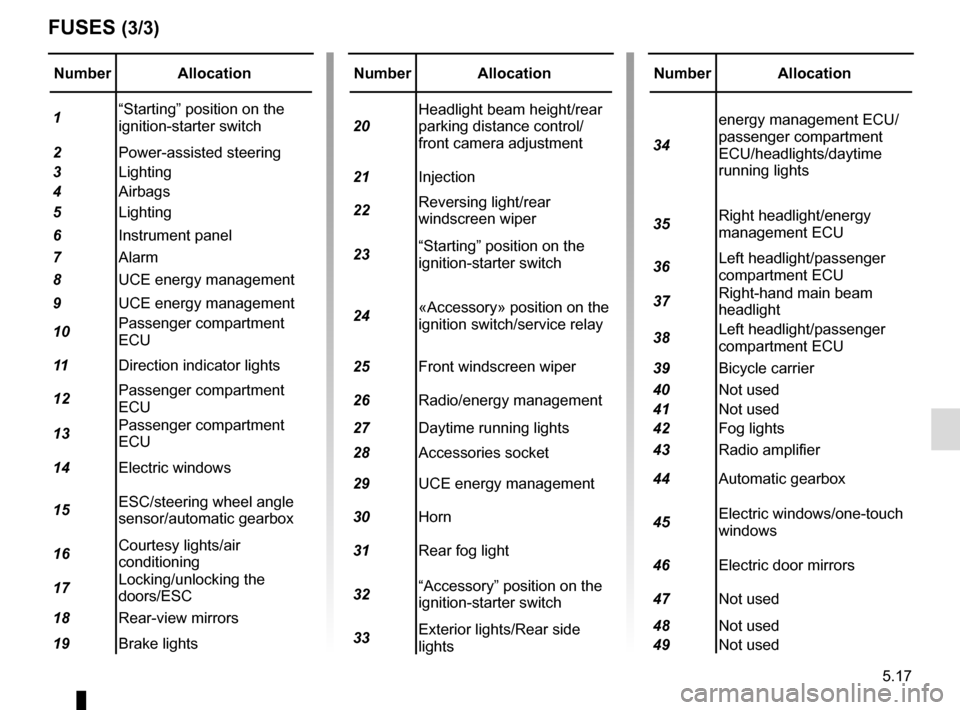
5.17
Number Allocation
1 “Starting” position on the
ignition-starter switch
2 Power-assisted steering
3 Lighting
4 Airbags
5 Lighting
6 Instrument panel
7 Alarm
8 UCE energy management
9 UCE energy management
10 Passenger compartment
ECU
11 Direction indicator lights
12 Passenger compartment
ECU
13 Passenger compartment
ECU
14 Electric windows
15 ESC/steering wheel angle
sensor/automatic gearbox
16 Courtesy lights/air
conditioning
17 Locking/unlocking the
doors/ESC
18 Rear-view mirrors
19 Brake lights
FUSES (3/3)
Number Allocation
20 Headlight beam height/rear
parking distance control/
front camera adjustment
21 Injection
22 Reversing light/rear
windscreen wiper
23 “Starting” position on the
ignition-starter switch
24 «Accessory» position on the
ignition switch/service relay
25 Front windscreen wiper
26 Radio/energy management
27 Daytime running lights
28 Accessories socket
29 UCE energy management
30 Horn
31 Rear fog light
32 “Accessory” position on the
ignition-starter switch
33 Exterior lights/Rear side
lightsNumber Allocation
34 energy management ECU/
passenger compartment
ECU/headlights/daytime
running lights
35 Right headlight/energy
management ECU
36 Left headlight/passenger
compartment ECU
37 Right-hand main beam
headlight
38 Left headlight/passenger
compartment ECU
39 Bicycle carrier
40 Not used
41 Not used
42 Fog lights
43 Radio amplifier
44 Automatic gearbox
45 Electric windows/one-touch
windows
46 Electric door mirrors
47 Not used
48 Not used
49 Not used